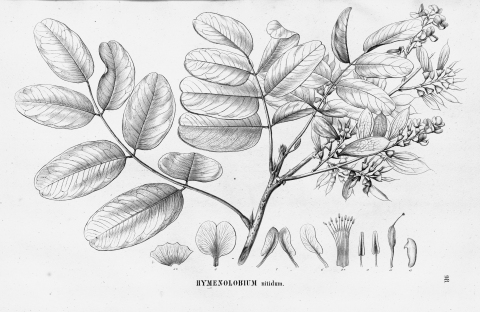Hymenolobium nitidum
Benth.
Fabaceae
Hymenolobium complicatum Ducke
Common Name:
General Information
Hymenolobium nitidum is a deciduous tree that can grow up to 20 metres tall[
461- Title
- Diccionario das Plantas Uteis do Brasil
- Publication
-
- Author
- Correa M.P.
- Publisher
- Imprensa Nacional; Rio de Janeiro
- Year
- 1926
- ISBN
-
- Description
- A massive work in 6 volumes giving details of the various uses of Brazilian plants.
].
The tree is harvested from the wild for its wood, which is a good quality construction timber that is used locally and also traded.
Known Hazards
The plant is placed in a bag, macerated, and allowed to stand in water as a means to immobilize fish for harvesting[
348- Title
- Medicinal Plants of the Guianas
- Publication
-
- Author
- DeFilipps, R. A.; Maina, S. L.; & Crepin, J.
- Website
- http://botany.si.edu/bdg/medicinal/index.html
- Publisher
- Smithsonian Museum
- Year
- 0
- ISBN
-
- Description
- A down-loadable PDF document of a book in pre-publication awaiting illustration. An excellent, if rather terse, guide to the traditional medicinal uses of the plants of the region
].
Botanical References
Range
S. America - northern Brazil, Peru, Venezuela.
Habitat
Rainforest.
Properties
| Other Uses Rating |      |
| Habit | Deciduous Tree |
| Height | 16.00 m |
| Cultivation Status | Wild |
Cultivation Details
This species has a symbiotic relationship with certain soil bacteria; these bacteria form nodules on the roots and fix atmospheric nitrogen. Some of this nitrogen is utilized by the growing plant but some can also be used by other plants growing nearby[
755- Title
- Nodulation Plants in GRIN Taxonomy
- Publication
-
- Author
-
- Website
- http://www.ars-grin.gov/~sbmljw/cgi-bin/taxnodul.pl?language=en
- Publisher
- United States Department of Agriculture
- Year
- 0
- ISBN
-
- Description
- An online database listing plants that have either positive or negative reports on root and stem nodulation with nitrogen-fixing bacteria.
].
Edible Uses
None known
Medicinal
None known
Other Uses
Most, if not all, members of this genus produce a heavy timber often used in construction[
485- Title
- Annals of the Missouri Botanical Garden. Vol 75
- Publication
-
- Author
-
- Website
- http://www.biodiversitylibrary.org
- Publisher
- Missouri Botanical Garden: Boston.
- Year
- 1988
- ISBN
-
- Description
- Contains, amongst other things, an article on the flora of Tanzania, a treatment of the genus Xyris and one for the Panamanian Boraginaceae. It can be downloaded from the internet.
]. We do not have a specific description for the wood of this species, but a general description for the genus is as follows:-
The heartwood is a yellow-brown, becoming pinkish-brown upon exposure, fairly important waxen patches are more or less frequent; it is not clearly demarcated from the 3 - 5cm wide band of sapwood. The texture is coarse; the grain interlocked. The wood is moderately heavy to heavy; moderately hard to hard; elastic; somewhat durable, being moderately resistant to fungi but susceptible to dry wood borers and termites. It seasons fairly quickly with only a slight risk of checking and distortion; once dry it is poorly to moderately stable in service. The wood works well with ordinary tools, though there are possible difficulties if the waxen patches are numerous; the waxen patches remain visible after machining; a careful sanding must be done to obtain a good finish; nailing and screwing are good, but require pre-boring, there is a tendency to end checks when nailing; gluing is correct. The wood is used in construction, joinery, panelling, industrial flooring, stairs, heavy carpentry, furniture components etc[
848- Title
- Tropix 7
- Publication
-
- Author
-
- Website
- http://tropix.cirad.fr/en
- Publisher
- CIRAD
- Year
- 0
- ISBN
-
- Description
- An on-line guide to the timbers of 245 species of trees.
].
Propagation
Seed -
If you have any useful information about this plant, please leave a comment. Comments have to be approved before they are shown here.


 Useful Tropical Plants Database 2014 by
Ken Fern,
web interface by
Ajna Fern
with help from
Richard Morris.
Useful Tropical Plants Database 2014 by
Ken Fern,
web interface by
Ajna Fern
with help from
Richard Morris.